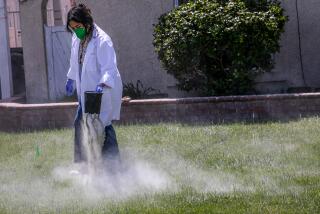Brazilian Blowout might be dangerous to your health
Controversy is swirling around a pricey and much-heralded hair-straightening treatment after researchers in Oregon announced recently that they had found that the formula contained the dangerous chemical formaldehyde, even in packages labeled formaldehyde-free.
The company behind the Brazilian Blowout responded with a series of statements on its website, first maintaining that the formula contains no formaldehyde and taking issue with Oregon’s test methods, then saying it conducted its own tests and concluded that the formula does indeed contain the chemical but in a trace amount that is “considered safe and allows for use of the term ‘formaldehyde-free.’ ”
Meanwhile the California Division of Occupational Safety and Health and other state agencies are also investigating the product and others like it, which have been the subject of complaints from some customers and hairstylists who’ve reported health side effects after using the treatments.
The Brazilian Blowout is perhaps the best known of the fairly new genre of keratin-smoothing treatments that are used to straighten frizzy or curly hair. The in-salon treatments usually cost $250 and up, but results leave hair soft and smooth and can last up to four months. Nicole Richie has raved about it on her blog, and a pantheon of celebrities is rumored to have tried it. At the International Salon and Spa Expo in Long Beach last winter, stylists flocked around a demonstration booth, clearly excited about the procedure, and it’s gained attention at numerous beauty-related websites and publications, including this one.
But as the treatments have grown in popularity, some stylists and clients have reported ill effects, such as headaches, nosebleeds, burning eyes and respiratory problems.
Researchers for the Oregon Health and Science University’s Center for Research on Occupational and Environmental Toxicology became interested in the issue when one of the center’s researchers was getting her hair done. “This stylist expressed her concern to the researcher about the Brazilian Blowout product — stylists were getting sick,” said Dede Montgomery, a certified industrial hygienist and occupational health and safety inspector at the center.
Showing her badge, Montgomery herself picked up opened bottles from Portland area salons and delivered them to the Department of Consumer and Business Services’ Oregon Occupational Safety and Health Division to be chemically analyzed. They tested two formulations, including the Brazilian Blowout Acai Professional Smoothing Solution labeled “formaldehyde free.” Using four test methods, researchers say they found the products to contain 10.6%, 6.3%, 10.6% and 10.4% formaldehyde.
“These values are high … too high,” says Dr. Wilma F. Bergfeld, chairwoman of the Cosmetic Ingredient Review panel and co-director of dermatopathology at the Cleveland Clinic. “CIR has limited the concentration of free formaldehyde in cosmetics to less than two-tenths of 1% in topical products. CIR would not consider a product with those reported formaldehyde levels to be safe.”
“I was surprised by the results,” says Montgomery, adding that if a product used in a workplace contains more than just 0.1% formaldehyde, Oregon OSHA has strict usage, employee education and disclosure requirements.
Brazilian Blowout’s statements maintain that its formula contains less than .0002% formaldehyde and question the Oregon study’s use of opened containers collected from salons. Unopened containers provided by the company itself, the statements said, would have ensured that the formula really was a Brazilian Blowout product rather than a competitor’s and that it hadn’t been contaminated. (The company did not return calls seeking further comment.)
Meanwhile, the Oregon researchers are standing by their results and doing more testing.
In California, formaldehyde is regulated under the state’s Safe Drinking Water and Toxic Enforcement Act, which deals with substances that can cause cancer or affect reproductive health, and under the California Safe Cosmetics Act. Cal/OSHA regulations protect employees’ health and safety, “but many hairstylists work as independent contractors who often rent their station,” and so aren’t considered to be employees, says Cal/OSHA spokeswoman Krisann Chasarik. Other agencies protect consumer health and safety.
Chasarik says independent contractors can refuse to do any potentially hazardous process. Stylists and clients should contact their local health department or the California Department of Consumer Affairs if they have concerns about a product’s safety.
While the issue is being sorted out, clients and stylists should know the symptoms and risks. Michael J. DiBartolomeis, head of the California Department of Public Health’s Safe Cosmetics Program, says short-term symptoms from breathing formaldehyde vapors include headache; watering, burning, irritated eyes; a severely irritated inner lining of the nose or a bloody nose; and restricted breathing, similar to an asthmatic attack. Longer-term exposure can cause reduced pulmonary function or lung damage and raises the risk of cancer.
If you have symptoms, consult a physician immediately, DiBartolomeis says. You should also report your concerns to Cal/OSHA if you are an employee or to the California Safe Cosmetics Program.
When considering formulas to use, don’t be fooled by unclear labeling. Formaldehyde is the simplest aldehyde, so look for that word on the label too, as well as glutaraldehyde.
Also be wary if overhead ventilation machines are being touted by a salon as a way to prevent problems from fumes. Such machines don’t guarantee safety and don’t help if formaldehyde is being absorbed through the skin, experts say.
Perhaps the safest advice: Get reacquainted with your blow-dryer and flat-iron. Good health trumps straight hair.
image@latimes.com
More to Read
Sign up for Essential California
The most important California stories and recommendations in your inbox every morning.
You may occasionally receive promotional content from the Los Angeles Times.









